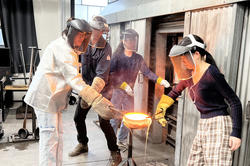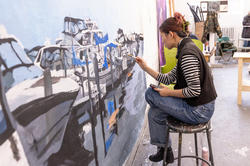Students in a fall course called Reorientations are challenging conventional approaches to theatrical set design and creating immersive cinematic experiences.
RISD’s Movement Lab Introduces Students to Puppeteering in Wintersession Studio

The audience inside RISD’s Metcalf Auditorium goes quiet as a giant dove moves slowly onto the stage, its wings swaying in time to hypnotic live guitar music. Soon, smaller sun and moon marionettes join the dance, eventually circling the room and silently greeting people in the audience.
The performance, by juniors Ian Kelewae 25 FAV and Anna MacLeod 25 FAV, is part of a puppetry cabaret created by students in a Wintersession course led by faculty member Andrew Murdock 13 FAV/SC. He is the first visiting puppeteer affiliated with RISD’s Movement Lab funded by RISD parent Cheryl Henson P 24, whose late father Jim Henson created the Muppets.
The Movement Lab arose from RISD’s unique approach to animation education. Based in the Film/Animation/Video department, it is a multidisciplinary research space for students, faculty and visiting artists. “Movement is a language that connects everything and everyone in conscious and unconscious ways,” says Department Head Max Porter 03 FAV.


Murdock pieced together his own puppetry-centric curriculum as an undergraduate student at RISD, dual-majoring in Sculpture and Film/Animation/Video. He began this course (ten years later) by asking the multidisciplinary group of students enrolled to explore the inherent movement of simple objects, like a stapler that chomps or a plastic bag that flies. From there the class moved quickly through several forms of puppetry, including shadow theater and Bunraku-style (puppets operated by three people, a form that comes from Japan) before moving into more self-directed final projects.
“My goal in developing this course was to help students create original live puppet performances drawing from a variety of traditions,” says Murdock. “In the weeks leading up to the cabaret, students worked through short exercises collaboratively in order to develop basic skills and generate ideas for their final pieces.”


In late January, experimental puppeteer Tom Lee visited the class and discussed his collaborations with kuruma ningyo master Koryu Nishikawa. An expert himself, Lee was part of the original Broadway cast of War Horse, the box office smash at the Lincoln Center Theater in NYC, from 2011–13. “Building the puppets is only half of the story,” he told students. “The second half is bringing them to life through movement.”
Lee began his career as an actor and says that as a puppeteer he has learned to channel the energy he previously expressed through movement and facial expressions into the puppet he’s working. Even though most contemporary puppeteers are unmasked and thus visible on stage as they work, audience members are so invested in the puppets as living characters, that the puppeteers essentially become invisible during performances.
“Collaboration is a conversation that involves listening and compromising,” Lee adds. “When you get into the zone on stage as a puppeteer, it’s almost like jazz improvisation!”
“When you get into the zone on stage as a puppeteer, it’s almost like jazz improvisation!”

A couple of weeks after Lee’s visit, students are getting into the zone at the final performance. Class TA Kat Warren 25 FAV serves as the show’s emcee, introducing each act and killing time between skits as (fictional) Hollywood has-been Savannah Sparks. A packed house—including longtime RISD puppet champion and Big Nazo creator Erminio Pinque 83 IL—watches first-year student John Cho 27 EFS kick off the show with a shadow theater comedy called The Rob. From there, the cabaret continues with solo and group performances combining hand puppets, directly controlled table-top puppets, marionettes and costume puppets (life-size characters played by students).
First-years Caroline Canty 27 EFS, Grace Ferrara 27 EFS and Kati Snotherly 27 EFS work together to animate Grandpa Phil for a sweet piece called Phil’s Soup-er Crazy Outing; and juniors Juhi Nagpal 25 FAV and Serena Xia 25 FAV team up with Pingping Huang 27 EFS on the ultra-relatable Pimple. For Grandma Rose, a poignant performance about aging, first-year student Sophia Chiu 27 EFS operates the flower puppets she made out of rope, while Canty and Snotherly provide the dialogue by holding up handwritten cue cards.
“Almost all of the students are first-time puppeteers, and they put on a great show,” says Murdock. “I’m so grateful for the opportunity to bring my love of the discipline back to RISD and help create a platform for this type of work.”
Simone Solondz / photos by Jo Sittenfeld MFA 08 PH
March 4, 2024


